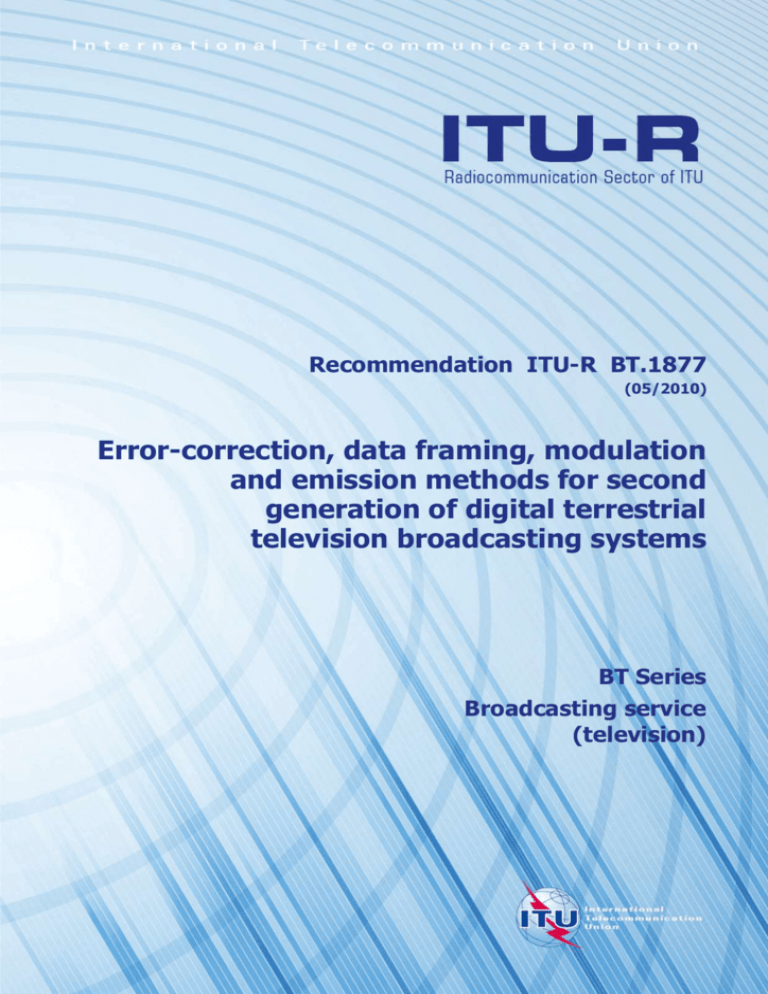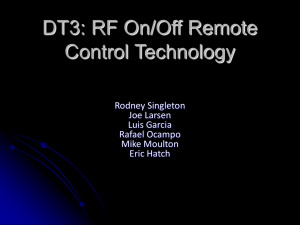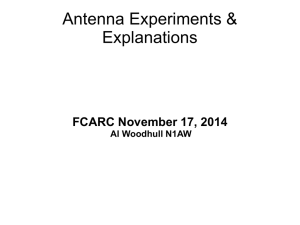
Recommendation ITU-R BT.1877
(05/2010)
Error-correction, data framing, modulation
and emission methods for second
generation of digital terrestrial
television broadcasting systems
BT Series
Broadcasting service
(television)
ii
Rec. ITU-R BT.1877
Foreword
The role of the Radiocommunication Sector is to ensure the rational, equitable, efficient and economical use of the
radio-frequency spectrum by all radiocommunication services, including satellite services, and carry out studies without
limit of frequency range on the basis of which Recommendations are adopted.
The regulatory and policy functions of the Radiocommunication Sector are performed by World and Regional
Radiocommunication Conferences and Radiocommunication Assemblies supported by Study Groups.
Policy on Intellectual Property Right (IPR)
ITU-R policy on IPR is described in the Common Patent Policy for ITU-T/ITU-R/ISO/IEC referenced in Annex 1 of
Resolution ITU-R 1. Forms to be used for the submission of patent statements and licensing declarations by patent
holders are available from http://www.itu.int/ITU-R/go/patents/en where the Guidelines for Implementation of the
Common Patent Policy for ITU-T/ITU-R/ISO/IEC and the ITU-R patent information database can also be found.
Series of ITU-R Recommendations
(Also available online at http://www.itu.int/publ/R-REC/en)
Series
BO
BR
BS
BT
F
M
P
RA
RS
S
SA
SF
SM
SNG
TF
V
Title
Satellite delivery
Recording for production, archival and play-out; film for television
Broadcasting service (sound)
Broadcasting service (television)
Fixed service
Mobile, radiodetermination, amateur and related satellite services
Radiowave propagation
Radio astronomy
Remote sensing systems
Fixed-satellite service
Space applications and meteorology
Frequency sharing and coordination between fixed-satellite and fixed service systems
Spectrum management
Satellite news gathering
Time signals and frequency standards emissions
Vocabulary and related subjects
Note: This ITU-R Recommendation was approved in English under the procedure detailed in Resolution ITU-R 1.
Electronic Publication
Geneva, 2010
ITU 2010
All rights reserved. No part of this publication may be reproduced, by any means whatsoever, without written permission of ITU.
Rec. ITU-R BT.1877
1
RECOMMENDATION ITU-R BT.1877
Error-correction, data framing, modulation and emission methods
for second generation of digital terrestrial television
broadcasting systems
(Question ITU-R 31/6)
(2010)
Scope
This Recommendation defines error-correction, data framing, modulation and emission methods for the
second generation of digital terrestrial television broadcasting transmission systems 1 (referred to, outside
ITU-R, as a DVB-T2 system). These systems have been developed such that they are compatible with the
provisions of the GE06 Agreement. This Recommendation is intended for the digital terrestrial broadcasting
transmission system, when high flexibility in the system configuration and broadcasting interactivity is of
importance allowing for a wide-ranging trade-off between operation under minimal C/N levels or maximum
transmission capacity2.
The ITU Radiocommunication Assembly,
considering
a)
that the digital terrestrial television systems for use in broadcasting systems have been
developed in Recommendation ITU-R BT.1306, which are referred to as the current systems;
b)
that digital terrestrial television broadcasting (DTTB) is being introduced in the VHF/UHF
bands by some administrations from 1997;
c)
that it may be desirable to support the simultaneous transmission of a hierarchy of nested
quality levels (including high definition television (HDTV), extended definition TV (EDTV)) and
standard definition TV (SDTV) within a single channel;
d)
that many types of interference, including co-channel and adjacent channel, ignition noise,
multipath and other signal distortions exist in the VHF/UHF bands;
e)
that it is necessary that the frame synchronization be capable of robustness in channels
subject to transmission errors;
f)
that it is desirable that the frame structure be adapted to different bit rate channels;
1
The second generation of digital terrestrial television broadcasting transmission systems in this
Recommendation is meant as systems offering higher bit rate capacity per Hz and better power efficiency
in comparison to the systems described in Recommendation ITU-R BT.1306, and there is no general
requirement for backward compatibility with first-generation systems.
2
For the first-generation systems information on planning parameters, protection ratios, etc. is already
contained in relevant ITU-R Recommendations. For the second-generation systems, there is a need to
study and include such information in the relevant ITU-R Recommendations.
2
Rec. ITU-R BT.1877
g)
that recent developments in the field of channel coding and modulation have produced new
techniques with performances approaching the Shannon limit;
h)
that these new digital techniques would offer better spectrum and/or power efficiency, in
comparison to the current systems, whilst maintaining the possibility to be flexibly configured to
cope with the specific broadcasting bandwidth and power resources;
j)
that the recommended system makes use of such techniques and thus allows for a wideranging trade-off between operation under minimal C/N levels or maximum transmission capacity;
k)
that the recommended system would be capable to handle the variety of advanced
audiovisual formats currently available and under definition;
l)
that the selection of a modulation option needs to be based on specific conditions such as
spectrum resource, policy, coverage requirements, existing network structure, reception conditions,
type of service required, cost to the consumer and broadcasters,
recommends
1
that administrations wishing to introduce the second generation of DTTB systems may use
the system outlined in Annex 1.
Annex 1
Table 1 provides data about the second-generation multi-carrier system with multiple physical layer
pipes (PLP). Specifications and implementation guidelines for this system (referred to, outside
ITU-R, as a DVB-T2 system) are found in Appendix 1.
Rec. ITU-R BT.1877
3
TABLE 1
Parameters for the second generation of DTTB transmission system
Second-generation multi-carrier system with multiple physical layer pipes (PLP)(1)
1.7 MHz multicarrier (OFDM)(2)
5 MHz multi-carrier
(OFDM)(2)
6 MHz multi-carrier
(OFDM)
7 MHz multi-carrier
(OFDM)
8 MHz multi-carrier
(OFDM)
10 MHz multicarrier (OFDM)(2)
1.54 MHz in normal
mode
4.76 MHz
in normal mode
4.82 MHz
in extended mode
(8k mode)
4.86 MHz
in extended mode
(16k and 32k mode)
5.71 MHz
in normal mode
5.79 MHz
in extended mode
(8k mode)
5.83 MHz
in extended mode
(16k and 32k mode)
6.66 MHz
in normal mode
6.75 MHz
in extended mode
(8k mode)
6.80 MHz
in extended mode
(16k and 32k mode)
7.61 MHz
in normal mode
7.72 MHz
in extended mode
(8k mode)
7.77 MHz
in extended mode
(16k and 32k mode)
9.51 MHz
in normal mode
9.65 MHz
in extended mode
(8k mode)
9.71 MHz
in extended mode
(16k and 32k mode)
1k mode
853
853
853
853
853
853
2k mode
1 705
1 705
1 705
1 705
1 705
1 705
4k mode
3 409
3 409
3 409
3 409
3 409
3 409
8k mode
6 817 (8k mode)
6 817 (8k mode)
6 913 (8k extended
mode)
6 817 (normal mode)
6 913 (extended mode)
6 817 (normal mode)
6 913 (extended mode)
6 817 (normal mode)
6 913 (extended mode)
6 817 (8k mode)
6 913 (8k extended
mode)
No.
Parameters
1
Used bandwidth
2
Number of
radiated carriers
3
16k mode
13 633 (16k mode)
13 921 (16k extended
mode)
13 633 (normal mode) 13 633 (normal mode) 13 633 (normal mode)
13 921 (extended mode) 13 921 (extended mode) 13 921 (extended mode)
13 633 (16k mode)
13 921 (16k extended
mode)
32k mode
27 265 (32k mode)
27 841 (32k extended
mode)
27 265 (normal mode) 27 265 (normal mode) 27 265 (normal mode)
27 841 (extended mode) 27 841 (extended mode) 27 841 (extended mode)
27 265 (32k mode)
27 841 (32k extended
mode)
Modulation
modes
Constant coding and modulation (CCM)/variable coding and modulation (VCM)
4
Rec. ITU-R BT.1877
TABLE 1 (continued)
No.
Parameters
4
Modulation
method
5
Channel
occupancy
6
Active symbol
duration
7
1.7 MHz multicarrier (OFDM)(2)
5 MHz multi-carrier
(OFDM)(2)
6 MHz multi-carrier
(OFDM)
7 MHz multi-carrier
(OFDM)
8 MHz multi-carrier
(OFDM)
10 MHz multicarrier (OFDM)(2)
QPSK, 16-QAM, 64-QAM, 256-QAM specific for each physical layer pipe
To be defined (2)
See Rec. ITU-R BT.1206
To be defined (2)
1k mode
554.99 μs
179.2 μs
149.33 μs
128 μs
112 μs
89.60 μs
2k mode
1 109.98 μs
358.4 μs
298.67 μs
256 μs
224 μs
179.20 μs
4k mode
2 219.97 μs
716.8 μs
597.33 μs
512 μs
448 μs
358.40 μs
8k mode
4 439.94 μs
1 433.6 μs
1 194.67 μs
1 024 μs
896 μs
716.8 μs
16k mode
2 867.2 μs
2 389.33 μs
2 048 μs
1 792 μs
1 433.6 μs
32k mode
5 734.40 μs
4 778.67 μs
4 096 μs
3 584 μs
2 867.2 μs
Carrier spacing
1k mode
1 801.91 Hz
5 580.63 Hz
6 696.75 Hz
7 812.88 Hz
8 929 Hz
11 161.25 Hz
2k mode
900.86 Hz
2 790 Hz
3 348 Hz
3 906 Hz
4 464 Hz
5 580.00 Hz
4k mode
450.43 Hz
1 395 Hz
1 674 Hz
1 953 Hz
2 232 Hz
2 790.00 Hz
8k mode
225.21 Hz
697.50 Hz
837 Hz
976 Hz
1 116 Hz
1 395.00 Hz
16k mode
348.75 Hz
418.5 Hz
488.25 Hz
558 Hz
697.50 Hz
32k mode
174.38 Hz
209.25 Hz
244.125 Hz
279 Hz
348.75 Hz
Rec. ITU-R BT.1877
5
TABLE 1 (continued)
No.
8
9
1.7 MHz multicarrier (OFDM)(2)
5 MHz multi-carrier
(OFDM)(2)
6 MHz multi-carrier
(OFDM)
7 MHz multi-carrier
(OFDM)
8 MHz multi-carrier
(OFDM)
10 MHz multicarrier (OFDM)(2)
1/128, 1/32, 1/16,
19/256, 1/8, 19/128,
1/4 of active symbol
duration
1/128, 1/32, 1/16,
19/256, 1/8, 19/128,
1/4 of active symbol
duration
1/128, 1/32, 1/16,
19/256, 1/8, 19/128,
1/4 of active symbol
duration
1/128, 1/32, 1/16,
19/256, 1/8, 19/128,
1/4 of active symbol
duration
1/128, 1/32, 1/16,
19/256, 1/8, 19/128,
1/4 of active symbol
duration
1/128, 1/32, 1/16,
19/256, 1/8, 19/128,
1/4 of active symbol
duration
1k mode
34.69, 69.37, 138.75 μs
11.2, 22.4, 44.8 μs
9.3, 18.6, 37.3 μs
8, 16, 32 μs
7, 14, 28 μs
5.6, 11.2, 22.4 μs
2k mode
34.69, 69.37, 138.75,
277.50 μs
11.2, 22.4, 44.8,
89.6 μs
9.3, 18.6, 37.3, 74.6 μs
8, 16, 32, 64 μs
7, 14, 28, 56 μs
5.6, 11.2, 22.4, 44.8 μs
4k mode
69.37, 138.75, 277.50,
554.99 μs
22.4, 44.8, 89.6,
179.2 μs
18.6, 37.3, 74.6,
149.3 μs
16, 32, 64, 128 μs
14, 28, 56, 112 μs
11.2, 22.4, 44.8,
89.6 μs
8k mode
34.69, 138.75, 277.50,
329.53, 554.99,
659.05, 1 109.98 μs
11.2, 44.8, 89.6, 106.4,
179.2, 212.8, 358.4 μs
9.3, 37.3, 74.6, 88.6,
149.3, 177.3, 298.6 μs
8, 32, 64, 75.9, 128,
152, 256 μs
7, 28, 56, 66.5, 112,
133, 224 μs
5.6, 22.4, 44.8, 53.2,
89.6, 106.4, 179.2 μs
16k mode
22.4, 89.6, 179.2,
212.8, 358.4, 425.6,
716.8 μs
18.6, 74.6, 149.3,
177.3, 298.6, 354.6,
597.3 μs
16, 64, 128, 152, 256,
304, 512 μs
14, 56, 112, 133, 224,
266, 448 μs
11.2, 44.8, 89.6, 106.4,
179.2, 212.8, 358.4 μs
32k mode
44.8, 179.2, 358.4,
425.6, 716.8, 851.2 μs
37.33, 149.33, 298.67,
354.67, 597.33,
709.33 μs
32, 128, 256, 304, 512,
608 μs
28, 112, 224, 266, 448,
532 μs
22.4, 89.6, 179.2,
212.8, 358.4, 425.6 μs
190.4, 201.6, 224 μs
158.6, 168, 186.6 μs
136, 144, 160 μs
119, 126, 140 μs
95.20-112.00 μs
264, 272, 288, 320 μs
231, 238, 252, 280 μs
184.80-224.00 μs
462, 476, 504, 560 μs
369.60-448.00 μs
Parameters
Guard interval
duration (3)
Overall symbol
duration
1k mode
589.68-4578.69 s
2k mode
1 144.67-1 387.48 μs
4k mode
2 289.34-2 774.96 μs
739, 762, 806, 896 μs
8k mode
4 474.63-5 549.92 μs
1 444.8, 1 478.4,
1 523.2, 1 540, 1 612.8,
1 646.4, 1 792 μs
1 204, 1 232, 1 269.3,
1 283.3, 1 344, 1 372,
1 493.3 μs
1 032, 1 056, 1 088,
1 100, 1 152, 1 176,
1 280 μs
903, 924, 952, 962.5,
1 008, 1 29, 1 120 μs
722.4, 739.2, 761.6,
770, 806.4, 823, 896 μs
16k mode
2 889, 2 956.8, 3 046.4,
3 080, 3 225.6, 3 292.8,
3 584 μs
2 408, 2 464, 2 538.6,
2 566.6, 2 686, 2 744,
2 986.6 μs
2 064, 2 112, 2 176,
2 200, 2 304, 2 352,
2 560 μs
1 806, 1 848, 1 904,
1 925, 2 016, 2 058,
2 240 μs
1 444.8, 1 478.4,
1 523.2, 1 540, 1 612.8,
1 646.4, 1 792 μs
32k mode
5 779.20-6 585.60 μs
4 816-5 488 μs
4 128-4 704 μs
3 612, 3 696, 3 808,
3 850, 4 032, 4 116 μs
2 889.6, 2 956.8,
3 046.4, 3 080, 3 225.6,
3 292.8 μs
369.6, 381, 403, 448 μs 308, 317, 336, 373.3 μs
616, 635, 672, 746.6 μs 527.9, 544, 576, 640 μs
6
Rec. ITU-R BT.1877
TABLE 1 (continued)
1.7 MHz multicarrier (OFDM)(2)
5 MHz multicarrier (OFDM)(2)
6 MHz multi-carrier
(OFDM)
7 MHz multi-carrier
(OFDM)
8 MHz multi-carrier
(OFDM)
10 MHz multicarrier (OFDM)(2)
No.
Parameters
10
Transmission
frame duration(6)
11
Input stream
format(4)
12
System stream
format
13
Mode adaptation
code
CRC-8
14
Channel coding
LDPC/BCH code with block size of 64 800 or 16 200 bits and code rates 1/2, 3/5, 2/3, 3/4, 4/5, 5/6 (1)
15
Interleaving
Bit, cell and time interleaving separately for each physical layer pipe. Common frequency interleaving (1)
16
Constellation
rotation
Optional, 29 (QPSK), 16.8 (16-QAM), 8.6 (64-QAM) degrees or atn (1/16) (256-QAM)
17
Physical layer
pipes (PLP)
Mode A with single PLP and mode B with multiple PLPs. Modulation, coding and time interleaving depth selectable separately for each PLP (1) (7)
18
Data
randomization/
energy dispersal
Initial scan
Frame starts with preamble and has a configurable number of symbols, with maximum duration of 250 ms. Minimum number of data symbols is 3
(32k mode) or 7 (other modes). Super-frame length is configurable, maximum 256 frames, 64 s
Either transport streams (TS) or generic streams (GS)
BB format(5)
BB format
PRBS
Fast scan process with special preamble symbol P1
19
Time/frequency
synchronization
20
MISO
21
Receiver power
consumption
reduction
22
Layer 1
signalling
L1 signalling is carried by P2 symbols in the preamble. L1 pre-signalling is modulated with BPSK and coded with 1/4 16k LDPC. L1 post-signalling
has configurable modulation and 1/2 16k LDPC coding. Option for in-band signalling within the PLP
23
Layer 1
signalling
Either within the data PLPs or with special common PLP at the beginning of the frame
Preamble symbols P1 and P2. Scattered pilot carriers with 8 different pilot patterns available. Continual pilots
An optional 2 × 1 Multiple Input Single Output (MISO) with Alamouti coding
Physical layer pipes are organized as subslices in the frame. When receiving a single PLP only the preamble and relevant subslices are received
and processed
Rec. ITU-R BT.1877
7
TABLE 1 (end)
No.
Parameters
24
PAPR (Peak-toAverage Power
Ratio)
25
1.7 MHz multicarrier (OFDM)(2)
Future
Extension
Frames (FEF)
26
Net data rate
27
Carrier-to-noise
ratio in an
AWGN channel
5 MHz multicarrier (OFDM)(2)
6 MHz multi-carrier
(OFDM)
7 MHz multi-carrier
(OFDM)
8 MHz multi-carrier
(OFDM)
Active Constellation Extension (ACE) and Tone Reservation (TR) as options
A super frame can include one or several FEF-parts. These can be used for future extensions of the system
4.01-37.8 Mbit/s,
depending on FFTsize, modulation, code
rate, guard interval,
pilot pattern, MISO,
FEF, PAPR
4.68-44.1 Mbit/s,
depending on FFTsize, modulation, code
rate, guard interval,
pilot pattern, MISO,
FEF, PAPR
5.35-50.4 Mbit/s,
depending on FFTsize, modulation, code
rate, guard interval,
pilot pattern, MISO,
FEF, PAPR
Depending on modulation and channel code. 0.8-21.8 dB(8)
BCH:
Bose – Chandhuri – Hocquenghem multiple error correction binary block code
LDPC:
Low density parity check
OFDM:
Orthogonal frequency division multiplex
PRBS:
Pseudo-random binary sequence
QAM:
Quadrature amplitude modulation
QSPK:
Quaternary phase shift keying.
10 MHz multicarrier (OFDM)(2)
8
Rec. ITU-R BT.1877
Notes relating to Table 1
(1)
Possibility for one or multiple physical layer pipes (PLP), each having its own specific modulation, coding
and time interleaving depth, thus enabling service-specific robustness.
(2)
Spectrum-shaping limits for digital terrestrial television systems using 5 MHz, 6 MHz and 10 MHz channels
needs to be defined. The 1.7, 5 and 10 MHz channel variants are not normally used for TV-broadcasting
purposes in the VHF III or UHF IV/V bands. The 7 and 8 MHz variants of the system are compatible with the
GE06 Agreement with respect to spectrum usage. The 1.7 MHz variant is compatible with T-DAB frequency
planning.
(3)
All the fractions are not available for all FFT-modes.
(4)
As defined in EN 302 755 (DVB-T2 standard), system support following input stream formats: GSE (Generic
Stream Encapsulated format), GFPS (Generic Fixed-length Packetized Stream format), GCS (Generic
Continuous Stream format) and MPEG-TS.
Base band format, used in this second-generation broadcasting system.
(5)
(6)
Values correspond to maximum frame length in OFDM symbols excluding P1 symbols. For 1k mode the
maximum length is defined for guard interval duration of 1/16, 1/8 and 1/4. For 4k and 2k modes the maximum
length is defined for 1/32, 1/16, 1/8 and 1/4. In the case of 32k mode non-applicable only 1/4 guard interval. For
more information see EN 302 755 (DVB-T2 standard). Number of OFDM symbols for 1.7 MHz, 5 MHz,
6 MHz, 7 MHz, 10 MHz is to be defined.
(7)
The system has a future option to spread the PLP subslices over multiple RF-channels within the frame.
Time interleaving is applied over all these. Single profile receivers based on the first release of the
specification do not support this.
Simulated in Gaussian channels with BER 1 × 10−4 before BCH coding. The expected implementation loss
due to real channel estimation needs to be added to the figures. This will be significantly less than the
corresponding figure for first-generation multi-carrier systems due to better optimization of the boosting
and pattern densities for second-generation multi-carrier systems.
(8)
Appendix 1
to Annex 1
System standard
ETSI
EN 302 755. Digital Video Broadcasting (DVB); Frame structure channel coding and modulation
for a second generation digital terrestrial television broadcasting system (DVB-T2).
ETSI
TR 102 831. Digital Video Broadcasting (DVB); Implementation guidelines for a second generation
digital terrestrial television broadcasting system (DVB-T2).







